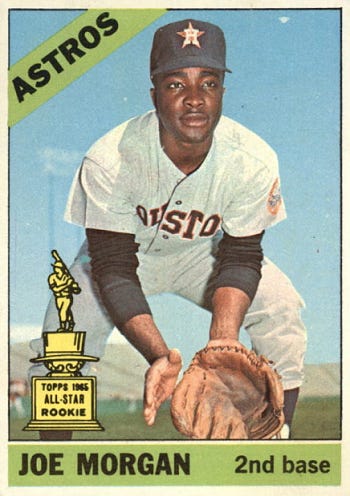The Blinding Brilliance of Early Joe Morgan
And the understated greatness of his "toy" teammate
1966 Topps Joe Morgan (#195) - Card of the Day
One look at some baseball cards will tell you all you need to know about the player depicted.
For instance, the 1977 Topps Dave Kingman tells you that Kong is a smasher.
The 1973 Topps Brooks Robinson reminds you that you’re not getting anything past him at third base.
And the 1984 Fleer Glenn Hubbard solidifies your resolve to keep him away from your daughter.
But other cards don’t tell you the whole story, no matter how great they look.
Take the 1966 Topps Joe Morgan, for example.
If you were a young collector in 1966, chances are you didn’t know much about Morgan unless you lived in the Houston area.
Sure, Morgan turned in an excellent rookie season in 1965, smacking 14 home runs in 601 at-bats to go along with a .271 batting average, 100 runs, and 20 stolen bases. That effort earned him second place in the National League Rookie of the Year balloting, well behind Los Angeles Dodgers second baseman Jim Lefebvre.
But just look at that gorgeous card that Topps used to celebrate Morgan’s rookie year.
The Little General is Born
Unless you just landed here from 1966 in your time machine, of course, you already know that Joe Morgan had other plans.
His home run output did dip into the single digits for most of his remaining six years in Houston, and his stolen base totals climbed as high as 49 by 1969. He made two All-Star teams and was generally one of the best second basemen in the Major Leagues.
Then, in late November of 1971, Morgan was traded to the Cincinnati Reds in a blockbuster trade that also netted Cincy Ed Armbrister, Jack Billingham, Cesar Geronimo, and Denis Menke in exchange for Tommy Helms, Lee May, and Jimmy Stewart.
As it turned out, this was the deal that put the finishing touches on The Big Red Machine.
Billingham claimed a slot in the rotation and Geronimo soon established himself as the Reds’ starting center fielder. Armbrister developed into a valuable role player whom manager Sparky Anderson played in all three outfield spots.
But Morgan was the prize of the trade who paid off more handsomely than anyone could have imagined.
Hitting second in the Reds lineup, Morgan got down to business the way he always did — getting on base, stealing bases, scoring runs. And, at age 28, he recorded a career-high 16 home runs in 1972 and landed fourth in the race for NL MVP.
The next year, he upped that homer total to 26 while remaining excellent everywhere else. He also won the first of five straight Gold Glove awards.
The power stuck with him and by the time the Machine was revving at full throttle to start the 1975 season, Morgan was batting third.
That 1975 team was one of the greatest to ever take the field, and the lineup was loaded like few others in Major League history. Despite sharing the dugout and diamond with unbelievable talents like Pete Rose, Johnny Bench, Tony Perez, George Foster, Dave Concepcion, and Ken Griffey, “Little Joe” Morgan was the best of the lot.
He won the National League MVP award and led the Reds to a World Series title in 1975 at age 31, then did it all again in 1976.
When Morgan finally hung up his spikes at age 41 in 1984, he had amassed 268 home runs among his more than 2500 hits. He scored more than 1600 runs and drove in more than 1100. His 689 stolen bases put him in eighth place when he retired.
As Topps predicted way back in 1966, Morgan had indeed become one of the best second baseman in baseball, and for all time.
Not bad for a guy who looked like for all the world like a light-hitting middle infielder waiting to happen on his 1966 Topps card.
Joe Morgan was born 81 years ago today.
Ties to the Toy Cannon
Morgan made his debut as a pinch hitter on September 21, 1963, but didn’t reach base.
The next day, he came in as a pinch runner in the bottom of the eighth inning against the Phillies. He then replaced Mike White at second base and finally came to bat again in the bottom of the ninth.
With two on and two out, Morgan singled against Johnny Klippstein to bring Jim Wynn home from third base — and to win the game, 2-1, for the Colt .45s.
A mere 14 years later, Joe Morgan was the two-time defending National League MVP and Wynn was making his final Topps appearance in an unfamiliar uniform.
Read all about that card right here.
—
Wynn is one of those guys who was great early in his career before fading, but who still ended up with numbers that rival or surpass some players who are already enshrined in the Hall of Fame.
Toy Cannon is not, and he probably won’t ever get much support given his relatively modest totals of 1665 hits and 291 home runs.
So…which players who aren’t in the Hall of Fame do you think should be in?
Thanks for reading.
—Adam
Like these stories and want to support them? Now you can contribute any amount you like via PayPal:
… or Buy Me a Coffee:








Should be in the Hall: Bobby Grich, Lou Whitaker, Andruw Jones, Jim Edmonds, Keith Hernandez, Bill Dahlen, Carlos Beltran. Possibles: Will Clark, Willie Randolph, Dwight Evans, Luis Tiant, Kevin Brown.
My personal top 3 for Should-Be-HOFers are Lou Whitaker, Dick Allen, and Bad Bill Dahlen. As a Sawx fan I can make cases for Dwight Evans and Luis Tiant, too.